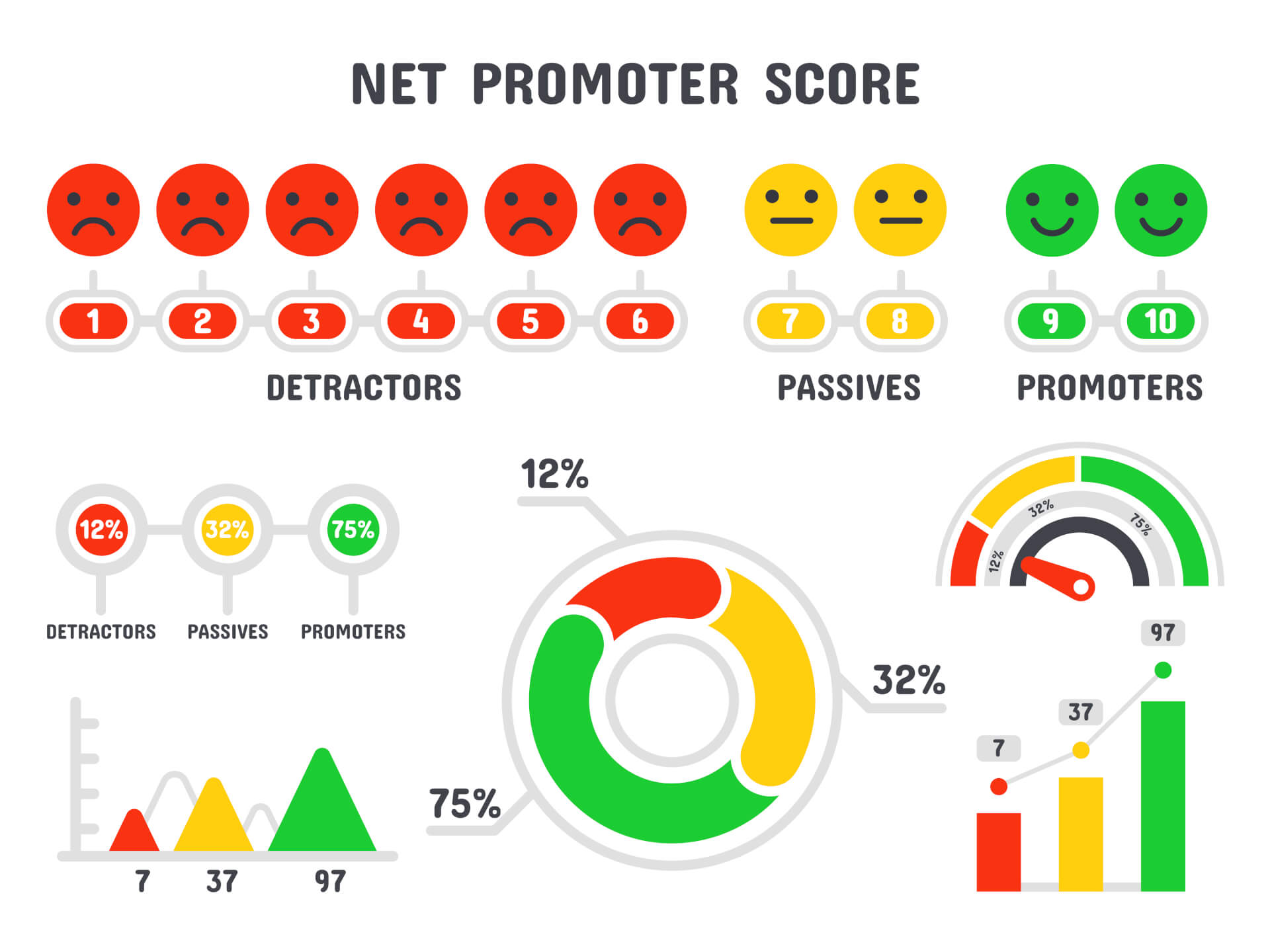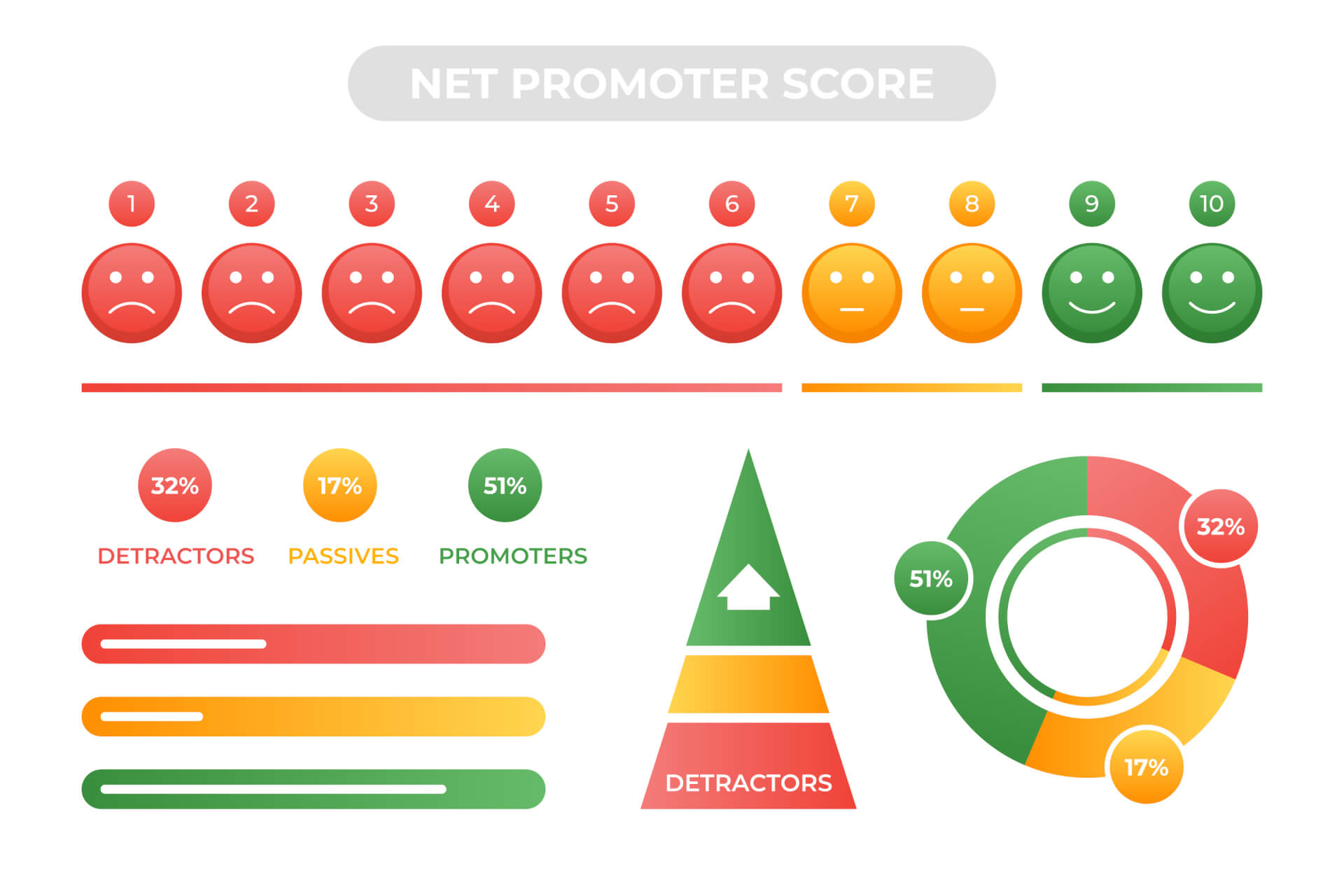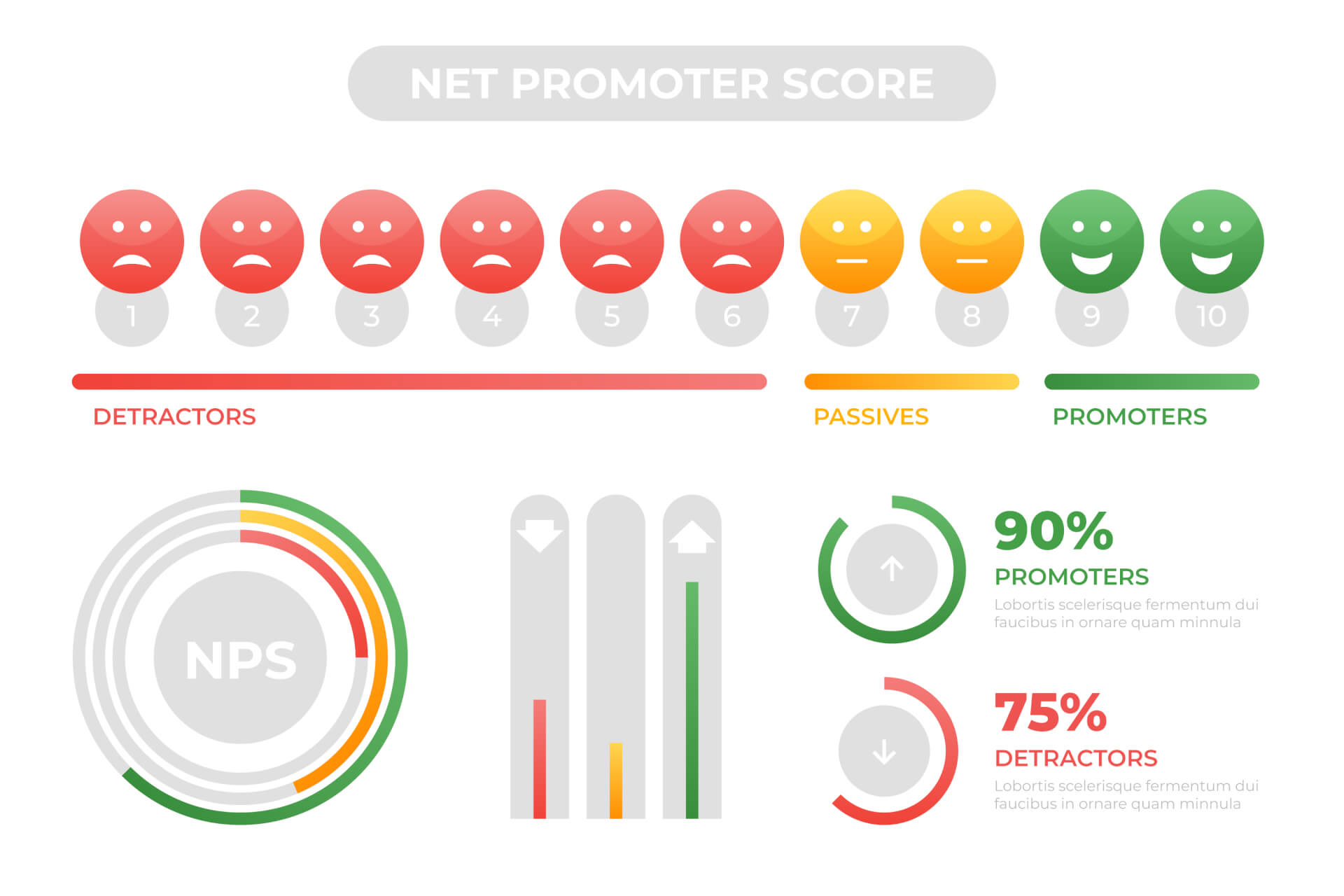The Net Promoter Score is a helpful tool that collects feedback and makes the satisfaction of your customers measurable.
Coupled with intelligent product analysis, proper segmentation and targeting, NPS - customer surveys can be a powerful tool to find your brand supporters, but conversely to identify the customers at high risk of churn. Used correctly, the Net Promoter Score provides valuable insights that can be used to make impactful decisions to improve customer loyalty.

Table of Contents
What is NPS?
Surveys based on the NPS formula are very specific surveys that allow you to get relevant information and actionable feedback from a single question, namely how likely it is that the respondent would recommend the brand, product or service to friends and acquaintances.
Based on the rating, customers are divided into 3 categories.

Critics - Ratings between 0 and 6 points.
These are customers who are not satisfied with your product or service.
Critics are more likely to share negative experiences and detract from the outward perception your product or service has.
Passive - ratings between 7 and 8 points.
These customers are neutral about your product or service – These customers don't hate it, but they're also in no hurry to recommend it to others. They run the risk of leaving the company and moving to another brand as there is no real commitment.
Promoter - ratings between 9 and 10 points.
These are your loyal brand supporters. These customers are happy with your product and loyal to your brand. You are willing to recommend your service and products to friends and family.
NPS is calculated by subtracting the percentage of supporters from the percentage of detractors. This results in a score between -100 and +100, which shows you how satisfied the customers are and how likely it is that they will be recommended. A good NPS is 50 or more.
In addition to these results, NPS surveys also contain at least one follow-up question, optimally aligned with the rating previously given. By asking why customers thinks the way they do, companies gain better insight into what they need to work on. For example, you can find out whether and what problems exist, whether processes do not make sense for customers and also what other services or products customers want.
In other words, a survey based on NPS provides:
- both qualitative and quantitative feedback.
- a simple way of surveying that we can answer quickly, which means that the respondents are more willing to take part in the survey.
This makes the NPS an extremely effective tool when used correctly. However, if you really want to understand your customers, you should not use NPS in isolation – it is the basis and the first step in further customer interaction and analysis.
However, the Net Promoter Score is not a silver bullet that will make all your product decisions for you. NPS is only one piece of the puzzle. Knowing when and how to use this metric makes all the difference.
When should NPS not be used?
 Don't use NPS if you're tracking it manually and want an accurate count of how many people like your product and how many don't.
Don't use NPS if you're tracking it manually and want an accurate count of how many people like your product and how many don't.
The background for this statement is the simple fact that the NPS answers can vary greatly depending on the customer segment. If you collect NPS manually, you'll either have a lot of hassle with segmentation, or you'll be faced with a long list of NPS results that give you little to no real insight into actual reactions.
Without detailed customer segmentation and breakdown by touchpoint, your NPS score alone won't tell you much about user sentiment, let alone provide you with actionable feedback.

Recommended reading: You can find more information about customer segmentation in our blog article "A quick guide to setting up customer segmentation with Callexa"
When should NPS be used?
 Use NPS when you are already collecting a lot of customer data.
Use NPS when you are already collecting a lot of customer data.
If you use this information to your advantage, segmenting the responses and dividing customers into groups, for example according to their buying habits, you will receive valuable feedback that you can use in both product development and marketing to target specific audiences. Segmentation also allows you to avoid asking the same customer the same question repeatedly, further increasing their willingness to participate.
With this approach, customers are more likely to respond and give you honest, and most importantly, thoughtful feedback.
You can also use the NPS if you want to use surveys across the entire customer journey. From onboarding and activation to subsequent customer retention, NPS helps you to guide your customers even better through the respective processes. Implemented correctly, the NPS survey makes it easy, quick and uncomplicated for you to find out which customers are at risk of leaving and which customers are already enthusiastic supporters of your brand.
How you can get even more out of the NPS survey

Allow additional details
Add a free text field to the survey for users to enter additional details about why they gave the score they gave. This way, you can gather more important insights.
Make sure you get the timing right
Avoid using NPS too early or at the wrong point in the customer journey. Allow your customers to get to know your company and your services a little before starting the survey. However, consider sending an NPS survey at multiple points in the customer lifecycle. People can have different opinions at different times.
Ask in the moment
In-app NPS surveys typically get more traction because they ask the question in the right context while customers are engaging with your product. Just be careful not to place the poll in an intrusive manner so you don't get in the way of the user. You can also use a combination of an in-app poll followed by an email version for users who don't respond.
Onboarding
 Customer onboarding is a big part of what makes your product successful and determines whether customers stay or leave. Start onboarding early and you have a better chance of retaining more customers over time.
Customer onboarding is a big part of what makes your product successful and determines whether customers stay or leave. Start onboarding early and you have a better chance of retaining more customers over time.
You can use NPS to find out what differentiates customers who are canceling from customers who are upgrading and how that affects your conversion rate. Immediately after a customer's trial expires, conduct a survey and ask those who churn how they find the service.
Depending on the response you get, there are a number of actions you can take. Let's use an example of how to increase the conversion rate in this context.
After the free trial ends, use NPS surveys to get qualitative feedback from customers directly on the end of the trial period. This gives you real-time insights that you can act on right away.
The goal in this case is not to see what score each customer gave them. The goal is to use the insights gathered via the NPS survey to reduce customer churn and increase sales.
A segmentation of the customers into the NPS classes promoters, passives and detractors is sufficient and also allows you to adapt the answers to the evaluation accordingly.
Along with the thank you, send the Promoter a discount to encourage them to upgrade to a paid plan.
You can offer passives an extension of the trial version and additional help with the configuration.
Critics receive a thank you email for the valuable feedback, which you then review closely and offer to contact the critic once the reported criticism has been resolved.
As you can see, it is quite easy to offer customers who are already convinced of your product or service a little push, or better yet, a suggestion to book a paid plan.
With NPS tools like Callexa, you can predefine the answers based on the score, which makes this form of conversion boost very easy and efficient.
Activation
 Activation is the second most important part of the customer journey. This is your chance to ensure the first few days with your product are the best.
Activation is the second most important part of the customer journey. This is your chance to ensure the first few days with your product are the best.
Activation impacts your growth potential further down the funnel because the sooner a customer understands and appreciates what you offer, the longer they'll stay with you.
NPS is a great tool to get customers to activate. By comparing your NPS survey responses to actual customer behaviors toward your product, you can begin to understand what behaviors separate your advocates from your detractors.
For activation, don't focus on turning a critic into a promoter. At this point, it's more important for promoters to have the "aha moment".
As soon as customers have the “aha moment” of your product – i.e. the point at which they experience the promised added value for the first time, it is easy to convince the customer of a paid plan.
Binding
 To encourage customer retention, contact customers based on their response. Again, this isn't about the score; this is just the first step. It's about the conversation you have with customers after the NPS survey.
To encourage customer retention, contact customers based on their response. Again, this isn't about the score; this is just the first step. It's about the conversation you have with customers after the NPS survey.
The score just helps you identify customer sentiment. It's about listening to your customers and helping them solve their problems. It is often overlooked how important it is to immediately follow up on every answer.
With NPS, you can solve the problems of dissatisfied customers and effectively reduce their churn.
Even if it took a few seconds to complete the survey, still take a moment to tell the customer that their input is valuable to you and will help improve the product.
Getting feedback is especially important when you've uncovered serious issues. A face-to-face follow-up gives you an additional opportunity to engage with customers to improve relationship and retention.
Write down some unique and relevant responses that address each group's needs. For example, ask critics to share more information about their experiences.
This approach has the following advantages. You can:
- address the pain points
- Understand how the customer will use the product and make suggestions to make it easier for the customer to use.
- Understand what customers like about your product and want to see more of it.
The goal here is to use the qualitative data you collect to not only improve your product and customer retention, but also tailor your communications to the needs of each NPS group.
Let the NPS work for you
NPS is a very useful tool; You just need to be aware of when and how to use it to get the most out of it. Only then will you receive meaningful information that offers real insights that you can use to work efficiently and successfully.
Callexa helps you to simplify and automate these processes and also to facilitate subsequent processing. Start today with your first survey. Our Callexa "Free" tariff is permanently free of charge and enables up to 50 recipients to be surveyed per month.
We are at your disposal if you have any questions about NPS or would like to arrange a demo for Callexa.
 Reading recommendation: If this article helped you and you would like to find out more about the Net Promoter Score, continue reading here: “The Net Promoter Score – Basics and Areas of Application”
Reading recommendation: If this article helped you and you would like to find out more about the Net Promoter Score, continue reading here: “The Net Promoter Score – Basics and Areas of Application”